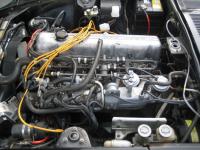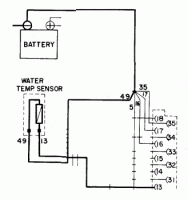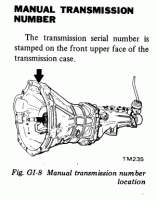Everything posted by 240260280z
-
Need to find some stiffer piston springs for my SUs
- Where do I find a body??
Q"Where do I find a body??" A The morgue? From my experience, Calif. Arizona, and Texas are great buy sometimes great Z's can show up anywhere.- A somewhat COLOR wiring diagram for 1978 280z's....ENJOY!
F a n t a s t i c !!! Thanks!- Need to find some stiffer piston springs for my SUs
I read that the springs are very long so as to maintain a relatively constant pressure from piston closed to open. It has to do with the small differential change in compressed spring length relative to the rest length.- Need to find some stiffer piston springs for my SUs
- Seeking dream car
http://dallas.craigslist.org/dal/cto/2795359485.html- EFI relay unplugged
Sort of, The AAR does not cause a lean condition because it is down steam from the AFM. So any air that it flows around the throttle valve through the AAR would have been drawn through the AFM and correspondingly more fuel added by the AFM detecting this. The AAR is basically just to keep the rpm's up on a cold winter morning so that your car can idle faster and not chug chug chug and die. On cars without AAR devices, you would have to sit in the car with foot on the gas and nurse it along until the engine came up to temp. Now with the AAR you can start the car then get out and scrape the windows without having to worry about it dying .- EFI relay unplugged
Well the AAR is just a "leak around the throttle valve to increase rpms when the engine is cold". In my friend's case, his idle was very high. When I pinched off the hose with my fingers during a test drive, the rpm's dropped immediately. In your case, the AAR may be working, or it could be stuck closed or it may be simply sticking.- EFI relay unplugged
No worries....btw I just diagnosed a bad AAR on a friend's car today.- Polishing crankshaft journals
Put a two wraps of the scotchbrite and several wraps of the cotton rope around it.- air fuel mixture??
There is a reference called the EFI bible that you should read. It explains everything.- air fuel mixture??
Go through this section and you should be all set. Fuel across the rpm range is determined by the needles shape. The screw for the jet height basically sets the point on the needle at idle. However there are many things to check: - cleanliness - free mechanical linkage (return springs, choke/jet drop) - synchronized linkage for both carbs - matched needles and needle height (where it is secured in piston) - matched jet depth - same piston rise/fall rates - no air leaks http://www.classiczcars.com/forums/forumdisplay.php?140-SU-Carb-Technical-Articles- Polishing crankshaft journals
I ran a cotton rope and scotch brite on the crank like this:- Today's dumb throttle linkage question
Actually you should all try driving with a bare foot/sock at least once. You really can do very fine adjustments as the sensitivity to pressure increases awareness of where the throttle is. I guess wearing those F1 booties instantly make you a better driver just by the improved tactile feed back and sensitivity.- EFI relay unplugged
Please run through the checks in post #28. If the AAR is working, and it is cold enough, your idle should be ~ 1200 to 1400 rpm as soon as you start. The pressing on the pedal bit seems strange... that indicates possibly a sticking throttle valve, weak return spring, slop in the linkage from the accelerator pedal to the throttle valve, binding in the linkage from the accelerator pedal to the throttle valve, or a malfunctioning dash pot. Possibly even the BCDD.- EFI relay unplugged
No problem. If all the parts are new,refreshed or cleaned then this is becoming more of a mystery. Lets try to methodically go through it. AAR is next based on what you noticed in post #12 above as the aar is supposed to hold a high idle when cold then it gradually reduces the idle. The Fuel/Air mixture should still be controlled by the AFM and temp sensors as the AAR is not an air leak. FYI some AAR's got gunked up because of the hose routing from the valve cover top.A change was done in '77 to reduce this: As you can see, the original routing is on the left and the modified is on the right. Gummy vented gases from the valve cover no longer got routed through the AAR after the mod. On some cars the T junction behind the AAR was capped but on others, the T was removed and a small metal pipe with rubber adapter was routed from the back of the AAR to the front boot hose. Like this: Your problem may even be something weird like the AFM flapper sticking. Let's findout- Anyone want a FairladyZ? Here's one for sale!
I drove a left hand drive in Ireland. Not too bad. Only toll booths/pay parking stands were awkward.- EFI relay unplugged
Water Temp. Sensor Ok, that shows you get 2.96kΩ at the sensor and at the ECU so your sensor and wiring are OK. One more test you can do for completeness is to bring the motor up to temperature then measure the resistance of the sensor. AAR Ok the Water temp sensor and wiring seems ok, and for the moment assume the ECU connector and ECU are working fine so let's look at the AAR. Take a quick look here: http://atlanticz.ca/zclub/techtips/aar/index.html Here is how to check: - Ensure your motor is cold. - Pull the hoses off each side of the AAR - Look through the AAR, you should be able to see through it. - Reconnect the hoses - Start the car then use pliers or vice grips or fingers to immediately squeeze one of the hoses feeding the AAR - When the hose is squeezed,the RPM's should drop. - Release the squeezing - Run the car for 10min - Again use pliers or vice grips or fingers to immediately squeeze one of the hoses feeding the AAR - When the hose is squeezed,the RPM's should NOT drop. - Turn off car - Pull the hoses again - Look through the AAR, you should not be able to see through it I also thought of a couple of new things to check that can make your idle inconsistent: - BCDD not working properly - Throttle Valve not closing properly (weak return spring or carbon) btw What is your idle rpm when your car is warmed up and you blip the pedal a few times?- EFI relay unplugged
I did a 2nd look and Pin 49 goes to ground so you should use a pin associated with gnd Pin 13 is the return from the temp sensor.- Transmission ID - What Transmission Am I "Supposed" to Have?
I have seen that on the bottom of this page: http://www.geocities.com/inlinestroker/ratio.html- EFI relay unplugged
I am sorry I am Canadian- Transmission ID - What Transmission Am I "Supposed" to Have?
- EFI relay unplugged
Sorry I have been travelling all day. OK that is step one done. Now measure at the ECU Connector at the driver's foot pedal (pins 13 and 49). It should read approximately the same resistance as at the sensor. Disconnect the battery -neg or +pos terminal before disconnecting at the ECU.- Fuel tank removal
fuel sender info: http://www.classiczcars.com/forums/showthread.php?43765-Hard-Wiring-The-Fuel-Sender-Connector&highlight=fuel+sender- EFI relay unplugged
This drawing shows what the EFI system does for any engine temp and rpm (x axis of graph). For your cold starts, everything on the left side of the graph is significant up to the x point of "Water Temp 158F 70C" All of the start enrichments are driven by the ECU except: 1. Cold Start Valve Increment (Which is driven by thermotime switch and the ecu) It fires only when cranking and only when the water temp is below 60F to 70F. After about 12sec of cranking, it no longer sprays. 2.Correction by Cooling Water Temperature (Which is driven by Water Temp. Sensor and ecu) 3.Correction by Intake Air Temperature (Which is driven by Air Temp. Sensor in AFM and ecu) My initial guess from your symptoms is water temp circuit. - Where do I find a body??
Important Information
By using this site, you agree to our Privacy Policy and Guidelines. We have placed cookies on your device to help make this website better. You can adjust your cookie settings, otherwise we'll assume you're okay to continue.










